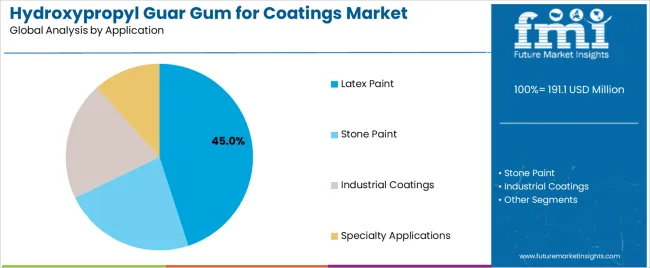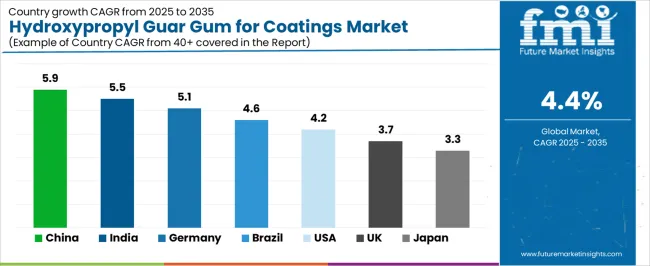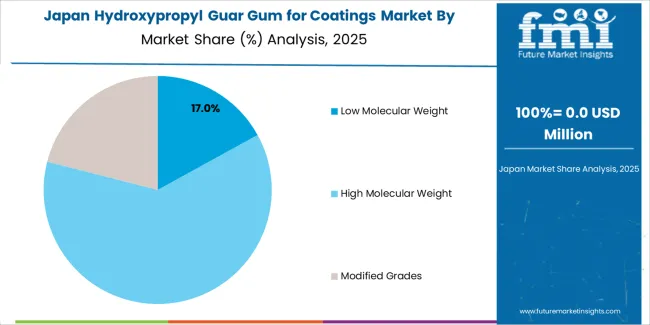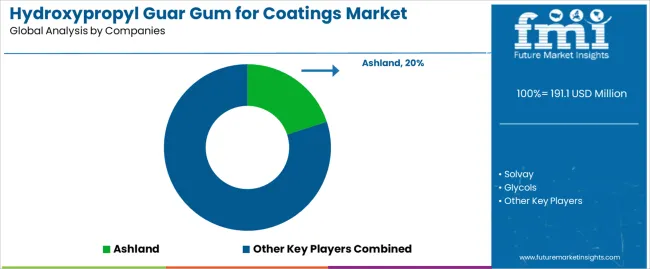The hydroxypropyl guar gum for coatings market is valued at USD 191.1 million in 2025 and is projected to reach USD 294.0 million by 2035, at a CAGR of 4.3% with a total value addition of USD 102.9 million over the decade, and on the supply side, production dynamics play a pivotal role in shaping competitive positioning. Guar gum is primarily sourced from guar seeds, with cultivation concentrated in India, and smaller volumes in the US and Africa, making raw material supply inherently linked to seasonal crop yields and agricultural price volatility. Processing facilities capable of chemically modifying guar to hydroxypropyl derivatives are relatively limited, with specialized plants in India, China, and select EU locations serving as major production hubs, which creates a moderately consolidated supply environment. The capital-intensive nature of producing high-purity derivatives, coupled with regulatory requirements for chemical handling, limits rapid entry of new players.
Producers are increasingly investing in backward integration with guar seed suppliers to reduce raw material price fluctuations, while forward integration with coating formulators ensures consistent off-take agreements. Technology upgrades in production are also shifting the supply structure, with enzymatic modification and green chemistry approaches gaining traction to reduce dependency on solvent-heavy processing. Scalability of production remains a key concern, as guar crops are exposed to monsoon variability in India, which accounts for over 70% of global output, creating a risk factor for consistent supply to coating manufacturers. On the production side, differentiation is achieved through particle size distribution, viscosity performance, and purity levels, with producers targeting customized grades for architectural coatings, industrial paint systems, and specialty formulations. High-performance hydroxypropyl guar derivatives are being manufactured with tighter rheology specifications to meet the needs of water-based systems, a trend accelerating as solvent-based paints decline in acceptance due to environmental regulations. Supply chains are also adapting, with coating manufacturers increasingly demanding on-time delivery and regional warehousing to manage inventory efficiency, leading producers to expand logistics networks across
North America and Europe. Cost structures remain highly sensitive to raw guar pricing, chemical reagent costs, and compliance with REACH and EPA guidelines, forcing producers to balance pricing strategies with performance innovation. Key production challenges include maintaining consistent batch quality across large-scale industrial runs and ensuring compatibility with automated paint formulation systems used by major coating companies.
| Period | Primary Revenue Buckets | Share | Notes |
|---|---|---|---|
| Today | High molecular weight grades | 62% | Superior thickening efficiency, architectural coatings |
| Low molecular weight grades | 28% | Specialized applications, industrial coatings | |
| Modified specialty grades | 10% | Custom formulations, premium applications | |
| Future (3-5 yrs) | Advanced high MW systems | 55-58% | Enhanced performance, digital integration |
| Specialized latex applications | 18-22% | Water-based systems, eco-friendly formulations | |
| Stone paint systems | 12-16% | Decorative coatings, texture applications | |
| Industrial coating applications | 8-12% | Heavy-duty coatings, protective systems | |
| Specialty formulation systems | 6-10% | Custom solutions, niche applications | |
| Digital coating platforms | 3-6% | Smart formulations, automated systems |
| Metric | Value |
|---|---|
| Market Value (2025) | USD 191.1 million |
| Market Forecast (2035) | USD 294.0 million |
| Growth Rate | 4.4% CAGR |
| Leading Product | High Molecular Weight Grade |
| Primary Application | Latex Paint Segment |
The hydroxypropyl guar gum for coatings market demonstrates strong fundamentals with high molecular weight hydroxypropyl guar systems capturing a dominant share through superior thickening efficiency and coating performance optimization. Latex paint applications drive primary demand, supported by increasing environmental regulations and water-based coating system modernization initiatives. Geographic expansion remains concentrated in developed markets with established paint manufacturing infrastructure, while emerging economies show accelerating adoption rates driven by construction industry growth and rising quality standards in coating applications.
Primary Classification: The market segments by molecular weight into low molecular weight, high molecular weight, and modified grades, representing the evolution from basic thickening agents to sophisticated rheology modifiers for comprehensive coating performance optimization.
Secondary Classification: Application segmentation divides the hydroxypropyl guar gum for coatings market into latex paint, stone paint, industrial coatings, and specialty applications, reflecting distinct requirements for viscosity control, application properties, and performance specifications.
Tertiary Classification: End-use segmentation covers architectural coatings, decorative paints, protective coatings, automotive refinish, and marine coatings, while distribution channels span direct sales, specialty chemical distributors, and paint additive suppliers.
Regional Classification: Geographic distribution covers North America, Latin America, Western Europe, Eastern Europe, East Asia, South Asia Pacific, and Middle East & Africa, with developed markets leading adoption while emerging economies show accelerating growth patterns driven by construction industry expansion and coating quality improvement programs.
The segmentation structure reveals product progression from traditional low molecular weight thickeners toward sophisticated high molecular weight systems with enhanced performance capabilities, while application diversity spans from residential paints to industrial protective coatings requiring precision rheology solutions.
Market Position: High molecular weight hydroxypropyl guar systems command the leading position in the coatings market with 62% market share through proven thickening technologies, including superior efficiency, excellent shear-thinning behavior, and coating performance optimization that enable paint manufacturers to achieve optimal application properties across diverse architectural and industrial coating environments.
Value Drivers: The segment benefits from coating industry preference for efficient thickening systems that provide superior viscosity control, excellent application properties, and operational efficiency without requiring complex additive packages. Advanced molecular weight control features enable enhanced coating stability, improved application characteristics, and integration with existing paint formulations, where performance effectiveness and cost efficiency represent critical operational requirements.
Competitive Advantages: High molecular weight systems differentiate through proven thickening reliability, superior coating performance, and integration with established paint manufacturing systems that enhance facility effectiveness while maintaining optimal coating quality suitable for diverse application requirements.
Key market characteristics:
Low molecular weight hydroxypropyl guar systems maintain a 28% market position in the coatings market due to their specialized application advantages and cost-effective positioning benefits. These materials appeal to facilities requiring efficient thickening solutions with specific rheological profiles for industrial and specialty coating operations. Market growth is driven by industrial coating expansion, emphasizing performance additive solutions and operational efficiency through optimized formulation designs.

Market Context: Latex paint applications demonstrate strong growth in the hydroxypropyl guar market 45% market share due to widespread adoption of water-based coating systems and increasing focus on environmental compliance, operational cost efficiency, and performance applications that maximize coating effectiveness while maintaining quality standards.
Appeal Factors: Paint manufacturers prioritize thickening reliability, application consistency, and integration with existing paint formulations that enables coordinated coating operations across multiple product lines. The segment benefits from substantial coating industry investment and modernization programs that emphasize the acquisition of advanced rheology modifiers for product differentiation and performance applications.
Growth Drivers: Water-based paint expansion programs incorporate hydroxypropyl guar as essential components for rheology control, while architectural coating growth increases demand for thickening capabilities that comply with environmental standards and minimize formulation complexity.
Market Challenges: Varying application requirements and formulation complexity may limit thickening standardization across different paint systems or coating scenarios.
Application dynamics include:
Stone paint applications capture 24% market share through specialized texture requirements in decorative coatings, architectural applications, and specialty coating systems. These facilities demand premium thickeners capable of supporting texture requirements while providing rheological control and performance capabilities.
Industrial coating applications account for 18% market share, including protective coatings, heavy-duty systems, and manufacturing applications requiring performance thickening capabilities for durability optimization and operational effectiveness.
Market Context: Architectural Coatings dominate the hydroxypropyl guar gum for coatings market with a 5.8% CAGR, reflecting the primary demand source for hydroxypropyl guar technology in building and construction applications.
Business Model Advantages: Architectural Coatings provide direct market demand for standardized thickening systems, driving volume production and cost optimization while maintaining quality control and performance requirements.
Operational Benefits: Architectural Coating applications include performance standardization, cost efficiency, and quality assurance that drive consistent demand for thickening systems while providing access to latest rheology technologies.
| Category | Factor | Impact | Why It Matters |
|---|---|---|---|
| Driver | Water-based coating growth & environmental regulations (VOC reduction, green building standards) | ★★★★★ | Growing demand for eco-friendly coatings requires natural thickening agents with enhanced performance capabilities and environmental compliance proven effective across coating applications. |
| Driver | Construction industry expansion & architectural coating demand (urbanization, infrastructure development) | ★★★★★ | Transforms thickening requirements from "basic additives" to "performance enhancers"; manufacturers that offer quality thickeners and technical support gain competitive advantage. |
| Driver | Paint quality improvement & formulation optimization (texture enhancement, application properties) | ★★★★☆ | Advanced paints need sophisticated thickening systems; demand for superior and specialized thickening solutions expanding addressable market. |
| Restraint | Raw material price volatility & supply chain challenges (guar price fluctuations) | ★★★★☆ | Smaller paint manufacturers defer thickener upgrades; increases price sensitivity and slows premium additive adoption in cost-conscious markets. |
| Restraint | Alternative thickening systems competition (synthetic thickeners, cellulose derivatives) | ★★★☆☆ | Synthetic alternatives offer established supply chains and consistent properties, potentially limiting hydroxypropyl guar adoption in traditional applications. |
| Trend | Molecular weight optimization & performance enhancement (rheology control, stability improvement) | ★★★★★ | Advanced molecular properties, application optimization, and performance analytics transform operations; technology integration and performance enhancement become core value propositions. |
| Trend | Digitalization & smart formulation systems (automated dosing, quality monitoring) | ★★★★☆ | Digital coating systems for automated applications; specialized monitoring and targeted performance capabilities drive competition toward digital solutions. |
The hydroxypropyl guar gum for coatings market demonstrates varied regional dynamics with Growth Leaders including China (5.9% growth rate) and India (5.5% growth rate) driving expansion through construction industry development initiatives and paint manufacturing modernization. Steady Performers encompass Germany (5.1% growth rate), Brazil (4.6% growth rate), and developed regions, benefiting from established coating industries and advanced thickening technology adoption. Mature Markets feature United States (4.2% growth rate), United Kingdom (3.7% growth rate), and Japan (3.3% growth rate), where coating advancement and formulation standardization requirements support consistent growth patterns.
Regional synthesis reveals East Asian markets leading adoption through construction expansion and paint manufacturing development, while North American countries maintain steady expansion supported by coating technology advancement and environmental compliance requirements. European markets show strong growth driven by architectural coating applications and quality integration trends.

| Region/Country | 2025-2035 Growth | How to win | What to watch out |
|---|---|---|---|
| China | 5.9% | Focus on volume manufacturing solutions | Regulatory changes; local competition |
| India | 5.5% | Lead with cost-effective production | Import restrictions; quality barriers |
| Germany | 5.1% | Provide premium quality thickeners | Over-regulation; lengthy approvals |
| Brazil | 4.6% | Offer value-oriented solutions | Currency fluctuations; import duties |
| United States | 4.2% | Push technology integration | Compliance costs; scaling challenges |
| United Kingdom | 3.7% | Focus on premium applications | Economic impacts; raw material costs |
| Japan | 3.3% | Emphasize quality manufacturing | Traditional preferences; adoption rates |
China establishes fastest market growth through aggressive construction development programs and comprehensive paint manufacturing industry expansion, integrating advanced hydroxypropyl guar systems as standard components in coating facilities and paint installations. The country's 5.9% growth rate reflects government initiatives promoting construction infrastructure and domestic coating capabilities that mandate the use of performance thickening systems in architectural and industrial coating facilities. Growth concentrates in major manufacturing hubs, including Beijing, Shanghai, and Guangzhou, where coating development showcases integrated thickening systems that appeal to paint manufacturers seeking rheological optimization capabilities and performance applications.
Chinese manufacturers are developing cost-effective thickening solutions that combine domestic production advantages with advanced molecular features, including enhanced stability control and improved application capabilities. Distribution channels through specialty chemical suppliers and coating additive distributors expand market access, while government support for construction development supports adoption across diverse paint and coating segments.
Strategic Market Indicators:
In Mumbai, Delhi, and Bangalore, paint facilities and coating manufacturers are implementing hydroxypropyl guar thickening systems as standard equipment for rheological control and performance optimization applications, driven by increasing government construction investment and manufacturing modernization programs that emphasize the importance of coating quality capabilities. The hydroxypropyl guar gum for coatings market holds a 5.5% growth rate, supported by government infrastructure initiatives and construction development programs that promote performance thickening systems for paint and coating facilities. Indian operators are adopting thickening systems that provide consistent rheological control and application features, particularly appealing in urban regions where coating performance and manufacturing excellence represent critical business requirements.
Market expansion benefits from growing coating capabilities and international technology partnerships that enable domestic production of performance thickening systems for paint and coating applications. Technology adoption follows patterns established in chemical manufacturing, where reliability and performance drive procurement decisions and operational deployment.
Market Intelligence Brief:
Germany's advanced coating market demonstrates sophisticated hydroxypropyl guar deployment with documented performance effectiveness in paint applications and coating facilities through integration with existing manufacturing systems and operational infrastructure. The country leverages engineering expertise in chemicals and quality systems integration to maintain a 5.1% growth rate. Manufacturing centers, including Bavaria, Baden-Württemberg, and North Rhine-Westphalia, showcase premium installations where thickening systems integrate with comprehensive coating platforms and facility management systems to optimize paint performance and operational effectiveness.
German manufacturers prioritize system quality and EU compliance in thickening development, creating demand for premium systems with advanced features, including facility integration and performance monitoring systems. The hydroxypropyl guar gum for coatings market benefits from established coating infrastructure and a willingness to invest in advanced thickening technologies that provide long-term operational benefits and compliance with international coating standards.
Market Intelligence Brief:
Brazil's market expansion benefits from diverse construction demand, including infrastructure modernization in Rio de Janeiro and São Paulo, paint facility upgrades, and government construction programs that increasingly incorporate performance thickening solutions for coating applications. The country maintains a 4.6% growth rate, driven by rising construction activity and increasing recognition of advanced thickening benefits, including precise rheological control and enhanced coating effectiveness.
Market dynamics focus on cost-effective thickening solutions that balance coating performance with affordability considerations important to Brazilian paint manufacturers. Growing construction industrialization creates continued demand for modern thickening systems in new coating infrastructure and facility modernization projects.
Strategic Market Considerations:
United States establishes market leadership through comprehensive coating programs and advanced paint manufacturing infrastructure development, integrating hydroxypropyl guar systems across architectural and industrial applications. The country's 4.2% growth rate reflects established coating industry relationships and mature thickening technology adoption that supports widespread use of performance thickening systems in paint and coating facilities. Growth concentrates in major manufacturing centers, including California, Texas, and Illinois, where thickening technology showcases mature deployment that appeals to coating manufacturers seeking proven rheological capabilities and operational efficiency applications.
American coating providers leverage established distribution networks and comprehensive technical support capabilities, including formulation programs and training support that create customer relationships and operational advantages. The hydroxypropyl guar gum for coatings market benefits from mature regulatory standards and environmental requirements that mandate thickening system use while supporting technology advancement and operational optimization.
Market Intelligence Brief:
United Kingdom's coating market demonstrates integrated hydroxypropyl guar deployment with documented performance effectiveness in paint applications and coating facilities through integration with existing manufacturing systems and operational infrastructure. The country maintains a 3.7% growth rate, supported by coating excellence programs and performance effectiveness requirements that promote advanced thickening systems for coating applications. Paint facilities across England, Scotland, and Wales showcase systematic installations where thickening systems integrate with comprehensive coating platforms to optimize paint performance and operational outcomes.
UK coating providers prioritize system reliability and industry compatibility in thickening procurement, creating demand for validated systems with proven performance features, including quality monitoring integration and rheological control systems. The hydroxypropyl guar gum for coatings market benefits from established coating infrastructure and excellence requirements that support thickening technology adoption and operational effectiveness.
Market Intelligence Brief:

Japan's market growth benefits from precision coating demand, including advanced paint facilities in Tokyo and Osaka, quality integration, and performance enhancement programs that increasingly incorporate thickening solutions for coating applications. The country maintains a 3.3% growth rate, driven by coating technology advancement and increasing recognition of precision thickening benefits, including accurate rheological control and enhanced coating outcomes.
Market dynamics focus on high-precision thickening solutions that meet Japanese quality standards and performance effectiveness requirements important to coating manufacturers. Advanced coating technology adoption creates continued demand for sophisticated thickening systems in paint facility infrastructure and manufacturing modernization projects.
Strategic Market Considerations:
The European hydroxypropyl guar gum for coatings market is projected to grow from USD 42.8 million in 2025 to USD 65.4 million by 2035, registering a CAGR of 4.3% over the forecast period. Germany is expected to maintain its leadership position with a 35.7% market share in 2025, supported by its advanced coating infrastructure and major paint manufacturing centers.
United Kingdom follows with a 26.2% share in 2025, driven by comprehensive coating programs and paint quality development initiatives. France holds a 19.6% share through specialized coating applications and chemical industry requirements. Italy commands a 11.9% share, while Spain accounts for 6.6% in 2025. The rest of Europe region is anticipated to gain momentum, expanding its collective share from 4.2% to 4.8% by 2035, attributed to increasing coating adoption in Nordic countries and emerging paint facilities implementing manufacturing modernization programs.

| Stakeholder | What they actually control | Typical strengths | Typical blind spots |
|---|---|---|---|
| Global specialty chemicals | R&D capabilities, broad product portfolios, global distribution | Wide availability, proven quality, multi-region support | Product refresh cycles; customer dependency on technical validation |
| Technology innovators | Molecular engineering; advanced guar derivatives; enhanced performance properties | Latest technologies first; attractive ROI on performance effectiveness | Service density outside core regions; scaling complexity |
| Regional specialists | Local compliance, fast delivery, nearby customer support | "Close to customer" support; pragmatic pricing; local regulations | Technology gaps; talent retention in technical service |
| Full-service providers | Formulation programs, technical services, application support | Lowest operational risk; comprehensive support | Service costs if overpromised; technology obsolescence |
| Niche specialists | Specialized grades, custom solutions, application expertise | Win premium applications; flexible configurations | Scalability limitations; narrow market focus |
| Item | Value |
|---|---|
| Quantitative Units | USD 191.1 million |
| Molecular Weight | Low Molecular Weight, High Molecular Weight, Modified Grades |
| Application | Latex Paint, Stone Paint, Industrial Coatings, Specialty Applications |
| End Use | Architectural Coatings, Decorative Paints, Protective Coatings, Automotive Refinish, Marine Coatings |
| Regions Covered | North America, Latin America, Western Europe, Eastern Europe, East Asia, South Asia Pacific, Middle East & Africa |
| Countries Covered | China, India, Germany, Brazil, United States, United Kingdom, Japan, Canada, France, Australia, and 25+ additional countries |
| Key Companies Profiled | Ashland, Solvay, Glycols, Vikas, Lamberti Group, GP Natural Products, Suzhou Synerguar Hydrocolloid Technologies, Guangrao Liuhe Chemical |
| Additional Attributes | Dollar sales by molecular weight and application categories, regional adoption trends across East Asia, North America, and Western Europe, competitive landscape with specialty chemical manufacturers and additive suppliers, paint manufacturer preferences for thickening effectiveness and rheological control, integration with coating platforms and formulation systems, innovations in molecular technology and thickening enhancement, and development of advanced thickening solutions with enhanced performance and operational optimization capabilities. |
The global hydroxypropyl guar gum for coatings market is estimated to be valued at USD 191.1 million in 2025.
The market size for the hydroxypropyl guar gum for coatings market is projected to reach USD 294.0 million by 2035.
The hydroxypropyl guar gum for coatings market is expected to grow at a 4.4% CAGR between 2025 and 2035.
The key product types in hydroxypropyl guar gum for coatings market are low molecular weight, high molecular weight and modified grades.
In terms of application, latex paint segment to command 45.0% share in the hydroxypropyl guar gum for coatings market in 2025.






Full Research Suite comprises of:
Market outlook & trends analysis
Interviews & case studies
Strategic recommendations
Vendor profiles & capabilities analysis
5-year forecasts
8 regions and 60+ country-level data splits
Market segment data splits
12 months of continuous data updates
DELIVERED AS:
PDF EXCEL ONLINE
Hydroxypropyl Distarch Phosphate Market Growth - Trends & Forecast 2025 to 2035
Guaranteed Auto Protection Gap Insurance Market Size and Share Forecast Outlook 2025 to 2035
Market Share Distribution Among Guar Complex Providers
Guarana Market Insights – Growth & Forecast 2016-2026
Guar Gum Market Growth & Demand Forecast 2024-2034
Safeguards for Passenger Transfer Area Market Size and Share Forecast Outlook 2025 to 2035
Grille Guard Market
Car Bumper Guard Market Size and Share Forecast Outlook 2025 to 2035
Window Rain Guards Market
Automotive Door Guards Market - Market Outlook 2025 to 2035
Two Wheeler Crash Guard Market Size and Share Forecast Outlook 2025 to 2035
Partially Hydrolyzed Guar Gum Market Size and Share Forecast Outlook 2025 to 2035
UV Coatings Market Growth & Forecast 2025 to 2035
2K Coatings Market Growth – Trends & Forecast 2025 to 2035
Coil Coatings Market Size and Share Forecast Outlook 2025 to 2035
Pipe Coatings Market Size and Share Forecast Outlook 2025 to 2035
Wood Coatings Market Size, Growth, and Forecast for 2025 to 2035
Smart Coatings Market Size and Share Forecast Outlook 2025 to 2035
Green Coatings Market Analysis by Technology, Application, and Region Forecast through 2035
Marine Coatings Market Size and Share Forecast Outlook 2025 to 2035

Thank you!
You will receive an email from our Business Development Manager. Please be sure to check your SPAM/JUNK folder too.
Chat With
MaRIA